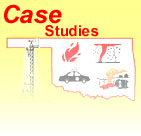![]()
|
|
|
|
 |
| Event Summary
Early in the evening of 26 April 1991, a strong tornado tracked through the south and east suburbs of Wichita, KS. The synoptic weather situation that occurred was typical of a springtime pattern in the central United States. Many tornadoes touched down that day from Nebraska to Texas, but the most devastating twister tracked just south of Wichita and flattened the Golden Spur Mobile Home Park in a town east of Wichita in Butler County. The Wichita/Andover tornado was spawned by a supercell thunderstorm that moved northeastward from northern Oklahoma into south-central Kansas. This thunderstorm produced four separate tornadoes along its path. The third and strongest tornado caused tremendous damage and destruction in Sedgwick and Butler Counties. This tornado reached an intensity of F5, the highest rating on the Fujita Tornado Intensity Scale; it was on the ground for approximately 46 miles from about 20 miles southwest of Wichita, near Clearwater, to 10 miles northeast of Wichita, near El Dorado. Twenty-four severe weather watches were issued on 26 April. In all, 71 tornadoes occurred, 69 of which were in the watches; all tornado deaths were in valid tornado watches. The National Weather Service started raising the red-flag of concern early on 25 April when they indicated in public releases that their computer models of the atmosphere were "indicating this to be a very significant severe weather producer with tornadoes occuring across the Central/Southern Plains." Early on the morning of April 26, the National Weather Service painted a "high risk" for tornadoes over the Plains. Statements later in the day stressed the high danger in this situation. The tornado watch number 183 was issued just after Noon, some six hours before the killer tornadoes struck in Kansas. On this same day, equally strong tornadoes moved over mostly open country in north Central Oklahoma. One of these tornadoes that passed near the town of Red Rock, Oklahoma, was intercepted by a chase team from the University of Oklahoma. This team used a portable Dopplar radar to measure 286 mph winds in the storm, the highest observed wind speed ever recorded up to that time. The National Weather Service also was conducting an operational test and evaluation of the NEXRAD radar system during this time, and data from these classic storms were captured by the first production NEXRAD unit in Oklahoma City. |
Objectives
|
|
| Conclusions
1. The Wichita/Andover tornado was one of a family of four tornadoes spawned by a thunderstorm with supercell characteristics that developed over north-central Oklahoma and moved northeast across south-central Kansas (Figure 1). A supercell is a strong thunderstorm that contains a deep, persistant rotation within the updraft. 2. The tornado outbreak of April 26 was typical of major outbreaks as several synoptic scale and mesoscale features combined to produce the extensive severe weather. At 7 AM CDT on 26 April, a surface low pressure system was located in southwestern Nebraska with a dry line extending southward into west Texas. Dew point temperatures in the lower to middle 60s (F) covered much of Oklahoma and Kansas, while dew points lowered into the 20s behind the dry line. A warm front extended from the low in Nebraska southeastward through Kansas into extreme northeastern Oklahoma. During the morning, the dry line moved rapidly eastward into western Oklahoma and central Kansas but slowed its progression considerably during the afternoon. 3. A low-level jet (at 850 millibars [mb] or about 5000 feet above sea-level) of 35 to 50 knots was evident on the 7 AM CDT data and extended from south-central Kansas northward into central North Dakota. The moist air 10° C or greater dew points, extended from southwest Texas into central Kansas. Drier air in western Texas and southwestern Kansas was beginning to push east and northeast on the heels of brisk west to southwest winds. 4. The atmosphere over the central United States was extremely unstable with a strongly sheared environment. Sounding-based stability indicies indicated very unstable conditions and supported severe thunderstorm development. For example, lifted index values (LI; at 7 AM CDT on 26 April) ranged from -5 to -7. Heat from the sun warmed the lower layers of the atmosphere and by afternoon. LIs reached -12 with the axis of greatest instability extending from central Oklahoma into central Kansas. 5. By 6 PM CDT on 26 April, the surface analysis indicated that the dry line had pushed eastward into central Kansas and Oklahoma. 6. By 7 PM CDT, the axis of warmest 850 mb temperatures extended from western Texas into western Kansas, east of Dodge City. The moist axis was located across central Oklahoma and eastern Kansas, just east of the warm air. The 850 mb dew points ranged from 13° to 17° C, an increase from the 7 AM CDT observations. The axis of maximum winds at 850 mb extended from north-central Oklahoma through eastern Kansas. 7. The final ingredient which appeared to initiate this severe weather out break was a band of maximum winds near the top of the troposhpere. This area of strong winds is referred to as the jet stream. Within the jet stream, there are regions of maximum winds referred to as a jet streak or a jet max. One such jet max was evident on satellite imagery through the day of 26 April. A jet max was rotating northeastward through western Kansas and the Oklahoma/Texas Panhandles around an upper level low located in Wyoming. 8. Most cumulus clouds along the dry line were unable to develop into thundestorms during the early afternoon. Convection developed rapidly once the upper level jet streak moved into a favorable position to support the upward motion in the atmosphere near the dry line. |